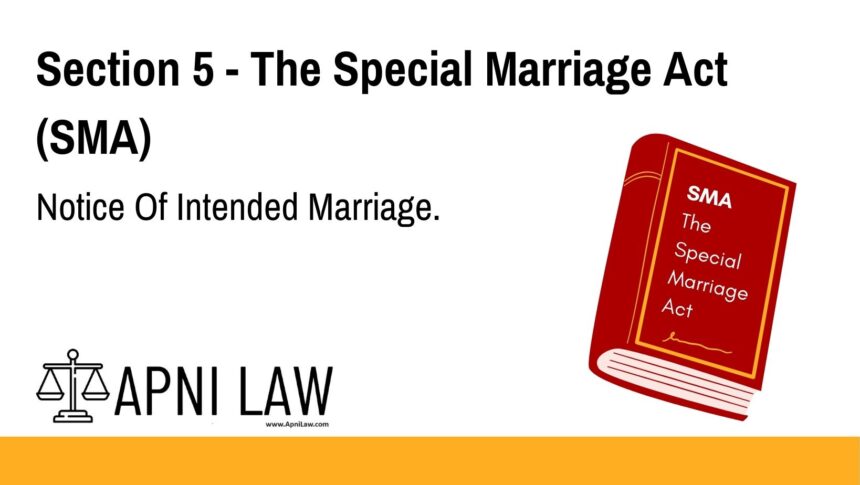Code: Section 5 – Notice of Intended Marriage
When a marriage is intended to be solemnized under this Act, the parties to the marriage shall give notice thereof in writing in the form specified in the Second Schedule to the Marriage Officer of the district in which at least one of the parties to the marriage has resided for a period of not less than thirty days immediately preceding the date on which such notice is given.
Explanation of Section 5 of the Special Marriage Act, 1954
Section 5 outlines the preliminary step for solemnizing a civil marriage under the Special Marriage Act — giving formal notice of the intended marriage. This provision is essential to initiate the legal process and allows for public scrutiny before the marriage is formally registered.
Here are the key requirements:
- 🔹 Written Notice: The couple must submit a written notice of their intention to marry.
- 🔹 Prescribed Form: The notice must be in the format specified in the Second Schedule of the Act.
- 🔹 Jurisdiction: The notice should be given to the Marriage Officer in the district where at least one of the parties has lived for a minimum of 30 days immediately before giving the notice.
This step is crucial because it starts the 30-day public notice period during which objections, if any, can be raised under Section 7 of the Act.
Illustration
🔸 Example:
Priya and Aamir plan to marry under the Special Marriage Act. Aamir has been living in Pune for over 30 days. They fill out the prescribed notice form and submit it to the Marriage Officer in Pune. The Officer then publicly displays the notice for 30 days as required by law.
Common Questions and Answers on Section 5 SMA
1. Is notice of intended marriage mandatory?
Yes. The notice under Section 5 is a legal prerequisite to solemnizing a marriage under the Special Marriage Act.
2. Can the notice be submitted online?
As of now, some states offer partial online facilities, but physical submission at the Marriage Officer’s office is typically required.
3. Who can submit the notice?
Either party to the intended marriage can submit the notice, but both must sign it.
4. Is it necessary for both partners to reside in the same district?
No. Only one party needs to have resided in the district for at least 30 days prior to submitting the notice.
5. What happens after the notice is given?
The Marriage Officer displays the notice for 30 days to allow objections. If no valid objection is raised, the marriage can be solemnized thereafter.
Conclusion
Section 5 of the Special Marriage Act is the legal entry point into a civil marriage process. It ensures transparency by allowing a public notice period and establishing jurisdiction for the Marriage Officer. This step reinforces the rule of law in marital procedures and protects the interests of all parties involved.
To learn more about the marriage process under SMA and download sample notice formats, visit ApniLaw today.








